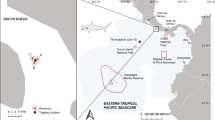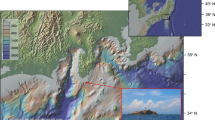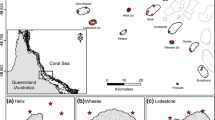Abstract
Assessing the movements and habitat use of wide-ranging predators is critical for understanding their role within an ecosystem and vulnerability to anthropogenic threats. The bronze whaler (Carcharhinus brachyurus) is a large-bodied, slow-growing shark species that is widely distributed throughout temperate Australian waters. Currently, habitat use, spatio-temporal presence and fine-scale movement information is unknown for Southern Australian waters. This study investigated the spatio-temporal patterns of occurrence, habitat use, and residency of bronze whalers in Gulf St. Vincent, South Australia. Forty-seven predominately small juvenile bronze whalers (83% of tagged sharks < 150 cm TL) were tagged with acoustic transmitters from 2009 to 2014 and monitored for periods of up to 55 months (range 516–1634 days; mean ± standard error 825 ± 47). The seasonal presence of bronze whalers peaked in spring–early autumn (September–April). Site fidelity was high, with 77% of tagged sharks detected over multiple years and 36% detected over 3 years. Low estimates of mean residency index (Ri = 0.05 ± 0.01) indicated that time spent within the array was limited. Shark occurrence was driven by a combination of factors, which included water temperature, season, moon illumination, and wind speed. Manly–Chesson’s Electivity Index showed bronze whalers exhibited the highest affinity to seagrass (Posidonia spp.), suggesting that this habitat plays an important role in the early life history stages. The slow growth and low productivity of bronze whalers combined with its predictable nearshore occurrence result in this species having an increased susceptibility to anthropogenic threats, which highlights the need for continued monitoring and vulnerability assessments.









Similar content being viewed by others
References
Bates DM (2010) lme4: mixed-effects modelling with R. Springer. http://lme4.r-forge.r-project.org/book
Baum JK, Myers RA, Kehler DG, Worm B, Harley SJ, Doherty PA (2003) Collapse and conservation of shark populations in the North Atlantic. Science 299:389–392
Bradshaw CJ, Prowse TA, Drew M, Gillanders BM, Donnellan SC, Huveneers C, Kuparinen A (2018) Predicting sustainable shark harvests when stock assessments are lacking. ICES J Mar Sci 75(5):1591–1601
Brodie S, Lédée EJ, Heupel MR, Babcock RC, Campbell HA, Gledhill DC, Hoenner X, Huveneers C, Jaine FR, Simpfendorfer CA, Taylor MD (2018) Continental-scale animal tracking reveals functional movement classes across marine taxa. Sci Rep 8(1):3717
Bruce BD (1992) Preliminary observations on the biology of the white shark, Carcharodon carcharias, in south Australian waters. Mar Freshw Res 43(1):1–11
Bryars S, Wear R, Collings G (2008) Seagrasses of Gulf St Vincent and investigator strait. In: Shepherd SA, Bryars S, Kirkegaard I, Harbison P, Jennings JT (eds) Natural history of Gulf St Vincent. Royal Society of South Australia, Adelaide, pp 132–147
Chapman DD, Pikitch EK, Babcock EA, Shivji MS (2005) Marine reserve design and evaluation using automated acoustic telemetry: a case-study involving coral reef-associated sharks in the Mesoamerican Caribbean. Mar Technol Soc J 39:42–55
Chapman DD, Feldheim KA, Papastamatiou YP, Hueter RE (2015) There and back again: a review of residency and return migrations in sharks, with implications for population structure and management. Ann Rev Mar Sci 7:547–570
Chiaramonte GE (1999) Shark fisheries in Argentina. Mar Freshw Res 49:601–609
Clarke C, Lea J, Ormond R (2011) Reef-use and residency patterns of a baited population of silky sharks, Carcharhinus falciformis, in the Red Sea. Mar Freshw Res 62:668–675
Cliff G, Dudley S (1992) Sharks caught in the protective gill nets off Natal, South Africa. 6. The copper shark Carcharhinus brachyurus (Günther). S Afr J Mar Sci 12:663–674
Drew M, Rogers P, Huveneers C (2017) Slow life-history traits of a neritic predator, the bronze whaler (Carcharhinus brachyurus). Mar Freshw Res 68:461–472
Dudley SF, Cliff G (2010) Influence of the annual sardine run on catches of large sharks in the protective gillnets off KwaZulu-Natal, South Africa, and the occurrence of sardine in shark diet. Afr J Mar Sci 32:383–397
Dulvy NK, Fowler SL, Musick JA, Cavanagh RD, Kyne PM, Harrison LR, Carlson JK, Davidson LN, Fordham SV, Francis MP (2014) Extinction risk and conservation of the world’s sharks and rays. Elife 3:e00590
Earl J, Fowler AJ, Dittmann S (2011) Temporal variation in feeding behaviour and trophic ecology of the temperate hemiramphid, Hyporhamphus melanochir. Environ Biol Fishes 90:71–83
Edyvane K (1999) Coastal and marine wetlands in Gulf St. Vincent, South Australia: understanding their loss and degradation. Wetl Ecol Manag 7:83–104
Escalle L, Speed C, Meekan M, White W, Babcock R, Pillans R, Huveneers C (2015) Restricted movements and mangrove dependency of the nervous shark Carcharhinus cautus in nearshore coastal waters. J Fish Biol 87:323–341
Espinoza M, Lédée EJ, Simpfendorfer CA, Tobin AJ, Heupel MR (2015) Contrasting movements and connectivity of reef-associated sharks using acoustic telemetry: implications for management. Ecol Appl 25(8):2101–2118
Feldheim KA, Gruber SH, Ashley MV (2004) Reconstruction of parental microsatellite genotypes reveals female polyandry and philopatry in the lemon shark, Negaprion brevirostris. Evolution 58:2332–2342
Ferretti F, Myers RA, Serena F, Lotze HK (2008) Loss of large predatory sharks from the Mediterranean Sea. Conserv Biol 22:952–964
Ferretti F, Worm B, Britten GL, Heithaus MR, Lotze HK (2010) Patterns and ecosystem consequences of shark declines in the ocean. Ecol Lett 13:1055–1071
Field I, Meekan M, Speed C, White W, Bradshaw C (2011) Quantifying movement patterns for shark conservation at remote coral atolls in the Indian Ocean. Coral Reefs 30:61–71
Fowler A, Huveneers C, Lloyd M (2017) Insights into movement behaviour of snapper (Chrysophrys auratus, Sparidae) from a large acoustic array. Mar Freshw Res 68(8):1438–1453
Francis MP (1998) New Zealand shark fisheries: development, size and mangement. Mar Freshw Res 49:579–591
Gallagher A, Jackson T, Hammerschlag N (2011) Occurrence of tiger shark (Galeocerdo cuvier) scavenging on avian prey and its possible connection to large-scale bird die-offs in the Florida Keys. Fla Sci 74(4):264–269
Gutteridge A, Bennett M, Huveneers C, Tibbetts I (2011) Assessing the overlap between the diet of a coastal shark and the surrounding prey communities in a sub-tropical embayment. J Fish Biol 78:1405–1422
Halpern BS, Walbridge S, Selkoe KA, Kappel CV, Micheli F, D’agrosa C, Bruno JF, Casey KS, Ebert C, Fox HE (2008) A global map of human impact on marine ecosystems. Science 319:948–952
Hammerschlag N, Skubel R, Calich H, Nelson E, Shiffman D, Wester J, Macdonald C, Cain S, Jennings L, Enchelmaier A (2017) Nocturnal and crepuscular behavior in elasmobranchs: a review of movement, habitat use, foraging, and reproduction in the dark. Bull Mar Sci 93:355–374
Harcourt RG, Bradshaw CJ, Dickson K, Davis LS (2002) Foraging ecology of a generalist predator, the female New Zealand fur seal. Mar Ecol Prog Ser 227:11–24
Heithaus MR (2004) Fish communities of subtropical seagrass meadows and associated habitats in Shark Bay, Western Australia. Bull Mar Sci 75:79–99
Heupel MR, Simpfendorfer CA, Fitzpatrick R (2010) Large-scale movement and reef fidelity of grey reef sharks. PLoS One 5:e9650
Hughes TP, Baird AH, Bellwood DR, Card M, Connolly SR, Folke C, Grosberg R, Hoegh-Guldberg O, Jackson J, Kleypas J (2003) Climate change, human impacts, and the resilience of coral reefs. Science 301:929–933
Hussey NE, Kessel ST, Aarestrup K, Cooke SJ, Cowley PD, Fisk AT, Harcourt RG, Holland KN, Iverson SJ, Kocik JF (2015) Aquatic animal telemetry: a panoramic window into the underwater world. Science 348:1255642
Huveneers C, Walker TI, Otway NM, Harcourt R (2007) Reproductive synchrony of three sympatric species of wobbegong shark (genus Orectolobus) in New South Wales, Australia. Mar Freshw Res 58:765–777
Huveneers C, Simpfendorfer CA, Kim S, Semmens JM, Hobday AJ, Pederson H, Stieglitz T, Vallee R, Webber D, Heupel MR (2016) The influence of environmental parameters on the performance and detection range of acoustic receivers. Methods Ecol Evol 7(7):825–835
Jones GK (2008) Review of the fishery status for whaler sharks (Carcharhinus spp.). In: South Australian and adjacent waters. SARDI Aquatic Sciences report, Adelaide, Australia
Kämpf J, Payne N, Malthouse P (2010) Marine connectivity in a large inverse estuary. J Coast Res 26:1047–1056
Kessarkar PM, Rao VP, Shynu R, Ahmad IM, Mehra P, Michael GS, Sundar D (2009) Wind-driven estuarine turbidity maxima in Mandovi Estuary, central west coast of India. J Earth Syst Sci 118(4):369–377
Last PR, Stevens JD (2009) Sharks and rays of Australia. CSIRO Australia, Australia
Lindstedt SL, Miller BJ, Buskirk SW (1986) Home range, time, and body size in mammals. Ecology 67(2):413–418
Lucifora LO, Menni RC, Escalante AH (2005) Reproduction and seasonal occurrence of the copper shark, Carcharhinus brachyurus, from north Patagonia, Argentina. ICES J Mar Sci 62:107–115
Lucifora LO, García VB, Menni RC, Escalante AH, Hozbor NM (2009) Effects of body size, age and maturity stage on diet in a large shark: ecological and applied implications. Ecol Res 24:109–118
Kock N, Lynn G (2012) Lateral collinearity and misleading results in variance-based SEM. An illustration and recommendations. J Assoc Inf Syst 13(7)
Maxwell SM, Hazen EL, Bograd SJ, Halpern BS, Breed GA, Nickel B, Teutschel NM, Crowder LB, Benson S, Dutton PH (2013) Cumulative human impacts on marine predators. Nat Commun 4:2688. https://doi.org/10.1038/ncomms3688
Momigliano P, Harcourt R, Robbins WD, Stow A (2015) Connectivity in grey reef sharks (Carcharhinus amblyrhynchos) determined using empirical and simulated genetic data. Sci Rep 5:13229
Mourier J, Planes S (2013) Direct genetic evidence for reproductive philopatry and associated fine-scale migrations in female blacktip reef sharks (Carcharhinus melanopterus) in French Polynesia. Mol Ecol 22:201–214
Pattiaratchi C, Jones R (2005) Physical and oceanographic studies of Adelaide coastal waters using high resolution modeling, in situ observations and satellite techniques—PPM 2 Sub Task 4 Draft Final Technical Report. ACWS Technical Report No. 8 prepared for the Adelaide Coastal Waters Study Steering Committee. Centre for Water Research, University of Western Australia, Nedlands WA 6907, July 2005
Payne NL, Gillanders BM, Webber DM, Semmens JM (2010) Interpreting diel activity patterns from acoustic telemetry: the need for controls. Mar Ecol Prog Ser 419:295–301
Petrusevics P (1993) SST fronts in inverse estuaries, South Australia-indicators of reduced gulf-shlef exchange. Mar Freshw Res 44:305–323
Pikitch E, Santora C, Babcock E, Bakun A, Bonfil R, Conover D, Dayton P, Doukakis P, Fluharty D, Heneman B et al (2004) Ecosystem-based fishery management. Science 305:346–347
Pinnegar J, Polunin N, Francour P, Badalamenti F, Chemello R, Harmelin-Vivien M-L, Hereu B, Milazzo M, Zabala M, d’Anna G (2000) Trophic cascades in benthic marine ecosystems: lessons for fisheries and protected-area management. Environ Conserv 27:179–200
Rogers PJ, Huveneers C, Page B, Hamer DJ, Goldsworthy SD, Mitchell JG, Seuront L (2012) A quantitative comparison of the diets of sympatric pelagic sharks in gulf and shelf ecosystems off southern Australia. ICES J Mar Sci (Journal du Conseil) 69:1382–1393
Rogers P, Huveneers C, Goldsworthy S, Cheung W, Jones G, Mitchell J, Seuront L (2013) Population metrics and movement of two sympatric carcharhinids: a comparison of the vulnerability of pelagic sharks of the southern Australian gulfs and shelves. Mar Freshw Res 64:20–30
Ruppert JL, Travers MJ, Smith LL, Fortin M-J, Meekan MG (2013) Caught in the middle: combined impacts of shark removal and coral loss on the fish communities of coral reefs. PLoS One 8:e74648
Shepherd S, Bryars S, Kirkegaard I, Jennings J, Harbison P (2008) Natural history of Gulf of St Vincent. Royal Society of South Australia, Adelaide
Sims DW, Wearmouth VJ, Southall EJ, Hill JM, Moore P, Rawlinson K, Hutchinson N, Budd GC, Righton D, Metcalfe JD, Nash JP (2006) Hunt warm, rest cool: bioenergetic strategy underlying diel vertical migration of a benthic shark. J Anim Ecol 75(1):176–190
Smale M (1991) Occurrence and feeding of three shark species, Carcharhinus brachyurus, C. obscurus and Sphyrna zygaena, on the Eastern Cape coast of South Africa. S Afr J Mar Sci 11:31–42
Smith SE, Au DW, Show C (1998) Intrinsic rebound potentials of 26 species of Pacific sharks. Mar Freshw Res 49:663–678
Speed CW, Field IC, Meekan MG, Bradshaw CJ (2010) Complexities of coastal shark movements and their implications for management. Mar Ecol Prog Ser 408:275–293
Speed C, Meekan M, Field I, McMahon C, Abrantes K, Bradshaw C (2012) Trophic ecology of reef sharks determined using stable isotopes and telemetry. Coral Reefs 31:357–367
Stevens JD, Bonfil R, Dulvy NK, Walker PA (2000) The effects of fishing on sharks, rays and chimaeras (chondrichthyans), and the implications for marine ecosystems. ICES J Mar Sci 57:476–494
Tanner J (2005) Three decades of habitat change in Gulf St. Vincent, South Australia. Trans R Soc S Aust 129:65–73
Thums M, Meekan M, Stevens J, Wilson S, Polovina J (2013) Evidence for behavioural thermoregulation by the world’s largest fish. J R Soc Interface 10(78):20120477
Tucker MA, Rogers TL (2014) Examining predator–prey body size, trophic level and body mass across marine and terrestrial mammals. Proc R Soc Lond B Biol Sci 281(1797):20142103
Vianna GM, Meekan MG, Meeuwig JJ, Speed CW (2013) Environmental influences on patterns of vertical movement and site fidelity of grey reef sharks (Carcharhinus amblyrhynchos) at aggregation sites. PLoS One 8:e60331
Walter JP, Ebert DA (1991) Preliminary estimates of age of the bronze whaler Carcharhinus brachyurus (Chondrichthyes: Carcharhinidae) from southern Africa, with a review of some life history parameters. S Afr J Mar Sci (Suid-Afrikaanse Tydskrif vir) 10:37–44
Yates PM, Heupel MR, Tobin AJ, Simpfendorfer CA (2015) Ecological drivers of shark distributions along a tropical coastline. PLoS One 10:e0121346
Zuur A, Ieno EN, Meesters E (2009) A Beginner’s Guide to R. Springer, Berlin
Acknowledgements
The authors would first like to thank the members of the Southern Shark Ecology Group, in particular Matthew Heard, Derek Dapp, Crystal Beckmann, and Lauriane Escalle. We would also like to thank SARDI Aquatic Sciences for their in-kind support with logistics throughout this project, in particular Anthony Fowler, Michael Steer and Simon Goldsworthy. We would especially like to thank, Shea Cameron and Luke Silvester of Flinders University for their assistance with receiver maintenance and The South Australian Royal Life Savers jet boat patrol group for their assistance in receiver maintenance.
Funding
This project was jointly funded by the Australian Post-graduate Award to MD, the Adelaide & Mount Lofty Ranges Natural Resources Management Board, the Neiser Foundation, the Nature Foundation of South Australia Inc, and the Tracking Research for Animal Conservation Society (TRACS). Some of the acoustic receivers were provided by the Institute of Marine and Antarctic Studies, the University of Adelaide, the Department of the Environment, Water and Natural Resources, and the Integrated Marine Observing System (IMOS) Animal Tracking Facility. IMOS is supported by the Australian Government through the National Collaborative Research Infrastructure Strategy and the Super Science Initiative
Author information
Authors and Affiliations
Corresponding author
Ethics declarations
Conflict of interest
The authors declare that they have no conflict of interest.
Ethical approval
All applicable international, national and/or institutional guidelines for sampling, care and experimental use of organisms for the study have been followed and all animal handling complied with the animal ethics standards of Flinders University animal ethics guidelines (Ethics approval #E360).
Additional information
Responsible Editor: J.K. Carlson.
Publisher's Note
Springer Nature remains neutral with regard to jurisdictional claims in published maps and institutional affiliations.
Reviewed by undisclosed experts.
Electronic supplementary material
Below is the link to the electronic supplementary material.
Rights and permissions
About this article
Cite this article
Drew, M., Rogers, P., Lloyd, M. et al. Seasonal occurrence and site fidelity of juvenile bronze whalers (Carcharhinus brachyurus) in a temperate inverse estuary. Mar Biol 166, 56 (2019). https://doi.org/10.1007/s00227-019-3500-x
Received:
Accepted:
Published:
DOI: https://doi.org/10.1007/s00227-019-3500-x




